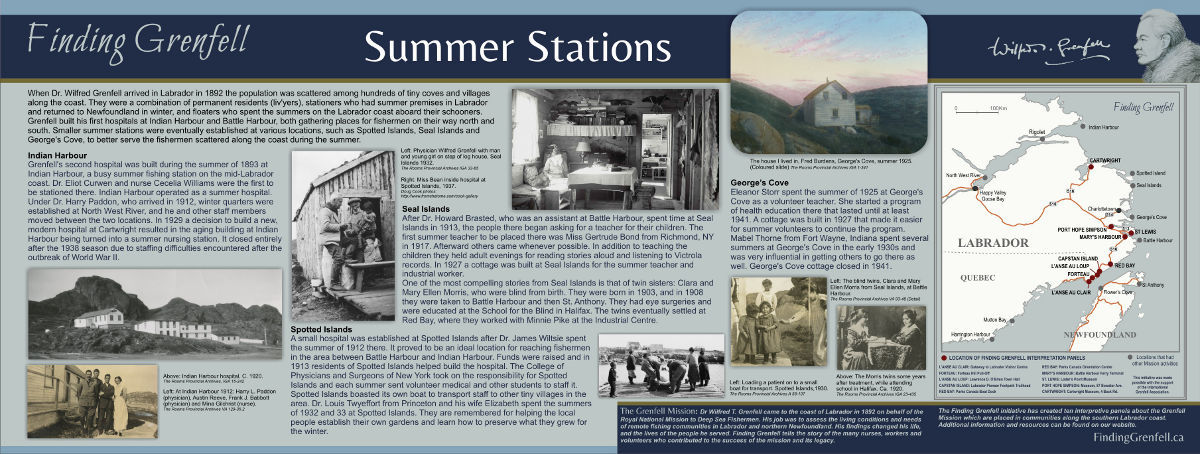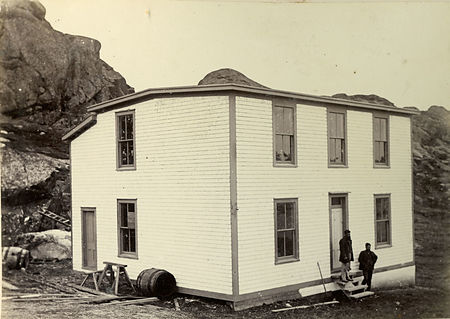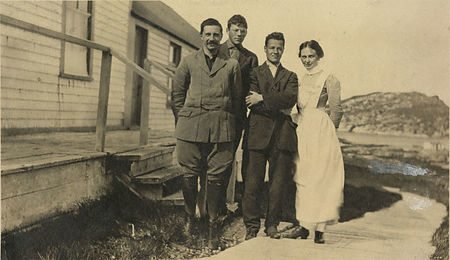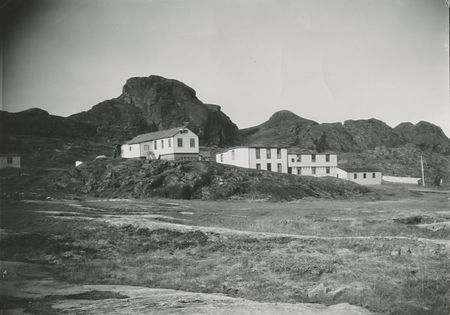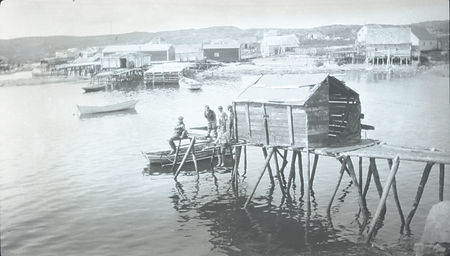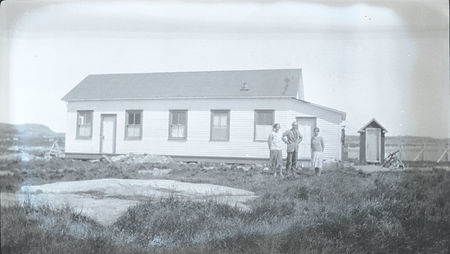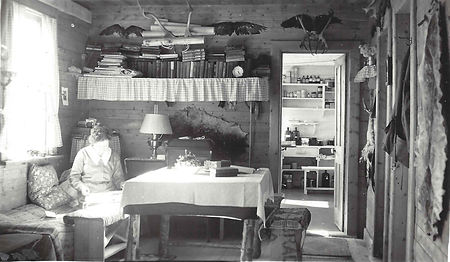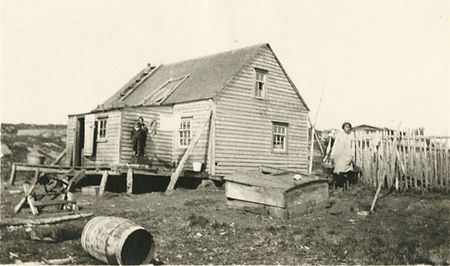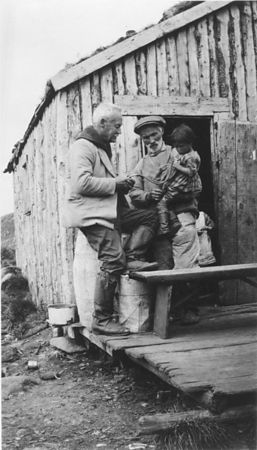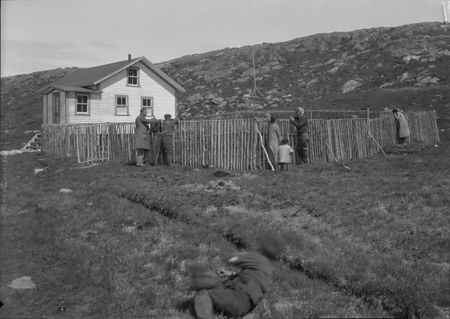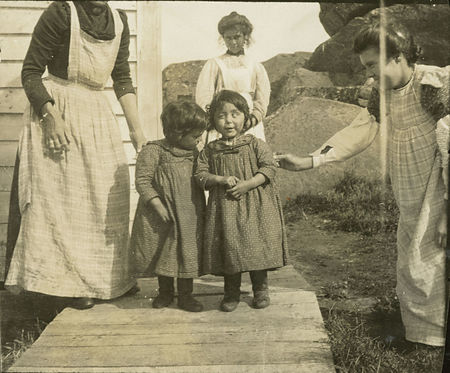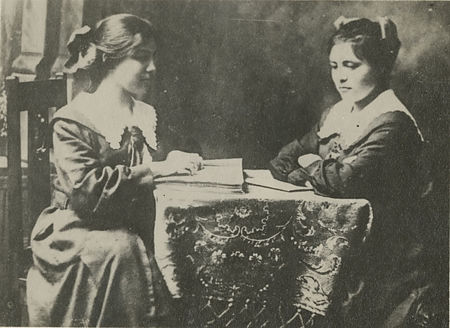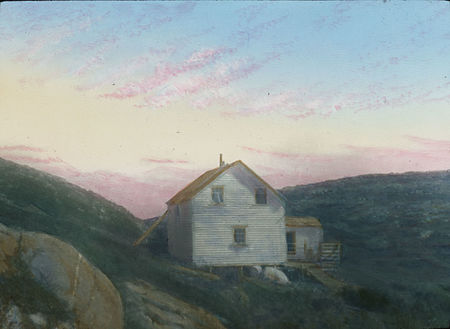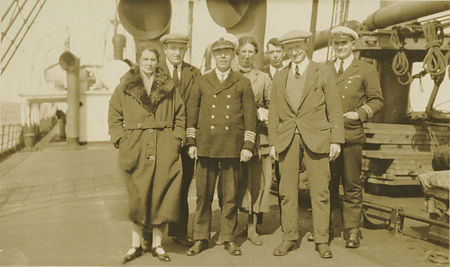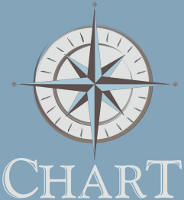Summer Stations
Indian Harbour
Indian Harbour was a summer fishing station located at the mouth of Groswater Bay on the mid-Labrador coast. Like Battle Harbour, it was a hub for the Labrador fishery, with many of the fishing schooners from Newfoundland gathering there on the way north and south. Grenfell established his second hospital there in 1894. The building was constructed during the summer of 1893. Dr. Eliot Curwen and nurse Cecelia Williams were stationed there that first summer. Indian Harbour operated as a summer hospital. Under Dr. Harry Paddon, who arrived in 1912, winter quarters were established at Northwest River, and he and other staff members moved between the two locations.
By 1929, the Grenfell Mission was making plans for major changes on the central Labrador coast. The decision to build a new school at Cartwright after the loss of the Muddy Bay School to fire in 1928 also led to a decision to build a new, modern year-round hospital at Cartwright. The number of seasonal fishermen and planters at Indian Harbour had been declining for a number of years, and a full size hospital could no longer be justified there. The building was also falling into disrepair. Indian Harbour would become a nursing station staffed in summer. Dora Burchill, an Australian nurse, was the last to be stationed at Indian Harbour in 1938. This was most likely a result of the difficulty in finding staff to come to Labrador once war broke out in Europe.
Spotted Islands
Dr. James W. Wiltsie, a medical student at Cornell University, first went to Spotted Islands during the summer of 1912. Spotted Islands is located about half way between Battle Harbour and Indian Harbour, so was an ideal location for reaching fishermen working between the two hospitals. In the beginning there was no intention to build a hospital at Spotted Islands, as the mission was more concerned about making sure what it already had established was properly funded and staffed. It was however, meant to be a student station — students paid their own travel expenses and did not receive a salary.
In 1913 funds had been raised for a building and it was constructed during the summer by Dr. Wiltsie and Princeton student T.K. Brown. The residents of Spotted Islands gave free labour to help build the dispensary, creating a permanent place for it in the community. In 1913 the College of Physicians and Surgeons agreed to take the Spotted Islands station under their wing and send a volunteer student each summer to staff it.
In 1915 a new motor boat called the P & S was given to the Spotted Islands station by Dr. Neil C. Stevens of the College of Physicians and Surgeons to replace the Pomiuk, which had been lost in a storm the previous fall.
Dr. Louis Twyeffort and his wife Elizabeth, from Princeton, New Jersey, spent the summers of 1932 and 33 at Spotted Islands. In addition to providing medical services, the Twyefforts are remembered for their work helping the residents create their own gardens. Every house had at least one garden and a community canning centre was set up to help people preserve food for the winter.
Seal Islands
The first presence of the Grenfell Mission at Seal Islands was during the summer of 1913, when Dr. Howard Brasted from the College of Physicians and Surgeons of New York, who was serving as assistant to Dr. Arthur Wakefield at Battle Harbour, spent some time there. The people of Seal Islands were asking for a teacher for their children. Ethel Gordon Muir, who led the volunteer summer teacher program, was inspiring the girls at her school in New York to raise money to support teachers in Labrador, including at Seal Islands.
The first teacher, Miss Gertrude Bond from Richmond Hill, New York, was placed there in the summer of 1917. In 1922 Miss Frances Kellogg from Vassar College was at Seal Islands. In addition to teaching the children, she also held evenings at the schoolroom for the adults in the community to listen to Victrola records or stories being read aloud. Lila C. Fisher from Boston came in the summer of 1924. The Hopkins family provided her with a house in which to live and teach the children: thirteen of them ranging from age 5 — 13. By the time Miss Fisher left at the end of the summer it was apparent that the Mission needed a building to continue.
In 1927 A. Burns Chalmers, who signed up to be a volunteer deckhand on the Strathcona II, was assigned the task of building an 18' x 24' cottage at Seal Islands. This cottage became the headquarters for summer teachers and industrial workers for a number of years. Alice Simms from St. Anthony was Industrial worker in the summers of 1928 and 29. Summer teachers included Newfoundlanders Winnie Grandy from Garnish in 1934 and Seneth Rowe from Heart's Content in 1936.
One of the most compelling stories from Seal Islands is that of the Morris sisters: Clara and Mary Ellen Morris were blind from birth. They were born at Seal Islands in 1903; in 1908 they were taken to Battle Harbour and then to St. Anthony. Eye surgeries improved their vision a little and they were educated at the School for the Blind in Halifax. The twins eventually settled at Red Bay, where they worked with Minnie Pike at the Industrial Centre there.
George's Cove
Eleanor Storr spent the summer of 1925 as a volunteer teacher at George's Cove. Storr had run the orphanage at St. Anthony about 15 years prior to this and was also involved in setting up an office for the IGA in London. She began a program of health education at George's Cove that carried on at least until 1941.
In 1927 a nurse's cottage was built, enabling summer volunteers to make more progress with health and education in the village. The person who became best known for her association with George's Cove was Mabel E. Thorne from Fort Wayne, Indiana. For several years between 1930 and 1935 she travelled to George's Cove as a volunteer teacher. Both during this time and afterwards she was instrumental in influencing others to follow her. For example, in 1940 she helped teacher Donna Lewis and nurse Celesta Gerber prepare for a summer at George's Cove. Miss Gerber did not return to Indiana for a long time — she married Gordon Acreman of Mary's Harbour and made Labrador her home.
After 1941 the station at George's Cove remained closed; it was reopened briefly in the summer of 1949 by teacher Marie Antoinette Robbins and clothing store director Kathleen C. (Corrie) Hodgson.
References
Indian Harbour
Dr. Harry Paddon wrote of activities at Indian Harbour during the summer of 1918 in a letter published in Among the Deep Sea Fishers, Vol 16(3), October 1918, pp. 102-03.
http://collections.mun.ca/cdm/compoundobject/collection/hs_fisher/id/285/rec/2
Stuart Mudd from the Harvard medical School wrote of his time at Indian Harbour in 1919 in "Impressions of the Labrador," Among the Deep Sea Fishers, Vol 17(4), January 1920, pp. 122-24.
http://collections.mun.ca/cdm/compoundobject/collection/hs_fisher/id/338/rec/3
Harold Thomas, MD, wrote of his experiences at Indian Harbour in the summer of 1915 in "A Summer at Indian Harbor Hospital," Among the Deep Sea Fishers, Vol 14(1), April 1916, pp. 16-20.
http://collections.mun.ca/cdm/compoundobject/collection/hs_fisher/id/2955/rec/9
Henry Kingsley Blake wrote of his experiences at Indian Harbour in the summer of 1916 in "A Summer at Indian Harbor," Among the Deep Sea Fishers, Vol 14(3), October 1916, pp. 106-08.
http://collections.mun.ca/cdm/compoundobject/collection/hs_fisher/id/2575/rec/10
Dr. Harry Paddon's report on work at Indian Harbour in the summer of 1917 is found on pages 147-49 of Among the Deep Sea Fishers, Vol 15(4), January 1918.
http://collections.mun.ca/cdm/compoundobject/collection/hs_fisher/id/224/rec/11
"The Army World Fliers at Indian Harbor" describes the landing of the first planes to circumnavigate the globe at Indian Harbour in 1924, after crossing the Atlantic from Greenland. Among the Deep Sea Fishers, Vol 22(3), October 1924, p. 98.
http://collections.mun.ca/cdm/compoundobject/collection/hs_fisher/id/4259/rec/14
Dr. Harry Paddon wrote a retrospective of the Indian Harbour Hospital as it was being turned into a nursing station in 1929 called "Vale, Indian Harbour," Among the Deep Sea Fishers, Vol 27(3), October 1929, pp. 108-11.
http://collections.mun.ca/cdm/compoundobject/collection/hs_fisher/id/1803/rec/15
Dr. W.A. Paddon wrote of his experiences as a child while his parents operated the summer hospital at Indian Harbour in "The Forgotten Years — 1912-1945," Among the Deep Sea Fishers, Vol 78(2), July 1981, pp. 6-12.
http://collections.mun.ca/cdm/compoundobject/collection/hs_fisher/id/8012/rec/9
Spotted Islands
A report of work carried out at Spotted Islands in 1920, called "A Summary of the Work Carried on by the P. and S. Medical Station" was written by George S. Reynolds and Stewart B. Sniffen and published in Among the Deep Sea Fishers, Vol 19(1), April 1921, pp. 10-16.
http://collections.mun.ca/cdm/compoundobject/collection/hs_fisher/id/3840/rec/4
A review of work at Spotted Islands in 1924 is found in "P & S on the Labrador — 1924," Among the Deep Sea Fishers, Vol 23(2), July 1925, pp. 71-75.
http://collections.mun.ca/cdm/compoundobject/collection/hs_fisher/id/4108/rec/88
A pieced called "Spotted Islands" appeared in Among the Deep Sea Fishers, Vol 11(1), April 1913, page 13.
http://collections.mun.ca/cdm/compoundobject/collection/hs_fisher/id/2030/rec/2
"A Summer on Spotted Island(s)" recounts the experiences of community worker Elizabeth Crawford and nurse Ruth Moser during the summer of 1954 in Among the Deep Sea Fishers, Vol 53(2), July 1955, pp. 38-43.
http://collections.mun.ca/cdm/compoundobject/collection/hs_fisher/id/5076/rec/3
Frank C. Johnson wrote of the experiences of three bachelors staffing the Spotted Islands Station during the summer of 1919 in "Spotted Islands Station, 1919," Among the Deep Sea Fishers, Vol 17(3), October 1919, pp. 83-85.
http://collections.mun.ca/cdm/compoundobject/collection/hs_fisher/id/3294/rec/9
Dr. Louis Twyeffort and his wife Elizabeth spent the summer of 1932 at Spotted islands. Mrs. Twyeffort wrote of the experience in "Spotted Islands — Summer of 1932," Among the Deep Sea Fishers, Vol 31(1), April 1933, pp. 30-33.
http://collections.mun.ca/cdm/compoundobject/collection/hs_fisher/id/4846/rec/1
Seal Islands
Lila Fisher's account of her summer at Seal Islands appears in Among the Deep Sea Fishers, Vol 22(3), October 1924, pp. 114-15.
http://collections.mun.ca/cdm/compoundobject/collection/hs_fisher/id/4259/rec/1
In 1965 Dr. John C. Stutzman met Mary Ellen (Morris) Hillyard at Red Bay. He wrote a short piece called "Throw them Overboard" that appeared in Among the Deep Sea Fishers, Vol 63(4), January 1966, page 108.
http://collections.mun.ca/cdm/compoundobject/collection/hs_fisher/id/6687/rec/1
George's Cove
Mabel E. Thorne's article called "Tuesdays" is an account of the summer of 1935 spent teaching summer school at George's Cove. It was published in Among the Deep Sea Fishers, Vol 33(3), October 1935, pp. 99-103.
http://collections.mun.ca/cdm/compoundobject/collection/hs_fisher/id/11334/rec/1
Isabelle Shoemaker recounts her summer at George's Cove as a summer teacher in 1932 in "A Summer at George's Cove," Among the Deep Sea Fishers, Vol 31(1), April 1933, pp. 27-30.
http://collections.mun.ca/cdm/compoundobject/collection/hs_fisher/id/4846/rec/4
Marie Antoinette Robbins wrote about opening the George's Cove station in the summer of 1949, after it had been closed for 8 years in "George's Cove Station Reopened," Among the Deep Sea Fishers, Vol 47(3), October 1949, pp. 73-75.
http://collections.mun.ca/cdm/compoundobject/collection/hs_fisher/id/10353/rec/3
Donna G. Lewis wrote of the summer that she and nurse Celesta Gerber spent at George's Cove in 1940 in "From Indiana to George's Cove," Among the Deep Sea Fishers, Vol 38(3), October 1940, Page 82.
http://collections.mun.ca/cdm/compoundobject/collection/hs_fisher/id/2208/rec/5
